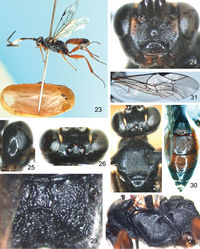Aptesis nigricoxa
| Notice: | This page is derived from the original publication listed below, whose author(s) should always be credited. Further contributors may edit and improve the content of this page and, consequently, need to be credited as well (see page history). Any assessment of factual correctness requires a careful review of the original article as well as of subsequent contributions.
If you are uncertain whether your planned contribution is correct or not, we suggest that you use the associated discussion page instead of editing the page directly. This page should be cited as follows (rationale):
Citation formats to copy and paste
BibTeX: @article{Li2013ZooKeys290, RIS/ Endnote: TY - JOUR Wikipedia/ Citizendium: <ref name="Li2013ZooKeys290">{{Citation See also the citation download page at the journal. |
Ordo: Hymenoptera
Familia: Ichneumonidae
Genus: Aptesis
Name
Aptesis nigricoxa Li & Sheng sp. n. – Wikispecies link – ZooBank link – Pensoft Profile
Etymology
The name of the new species is based on the black coxae.
Types
Holotype, female, CHINA: Weining County, Guizhou Province, 26 February 2012, leg. Mao-Ling Sheng. Paratype: 1 female, CHINA: Weining County, Guizhou Province, 1 March 2012, leg. Tao Li. Both specimens reared from Neodiprion huizeensis.
Diagnosis
Clypeus about 1.9 to 2.0 times as wide as long. Malar space approximately 1.2 to 1.4 times as long as basal width of mandible. Postocellar line approximately 1.5 times as long as ocular-ocellar line. Antenna with 30 to 31 flagellomeres. Fore wing vein 3rs-m almost parallel with 2rs-m. Vein 2-Cu approximately 1.5 times as long as 2cu-a. First tergum about 1.5 times as long as apical width. Ovipositor sheath about 0.7 times as long as hind tibia.
Description
Female (Fig. 23). Body length 6.0 to 8.5 mm. Fore wing length 6.0 to 7.0 mm.
Head. Face (Fig. 24) about 2.0 to 2.1 times as wide as long, with short brown setae and dense punctures; centrally weakly convex, punctures sparser than remainder of face; face orbits granulose with sparse punctures. Epistomal suture distinct. Clypeus about 1.9 to 2.0 times as wide as long, with sparse punctures; basally evenly convex; apically flat, with transverse wrinkles, apical margin distinct. Mandible strong, with dense fine punctures; upper tooth slightly longer than lower tooth. Malar space with fine granulose texture, approximately 1.2 to 1.4 times as long as basal width of mandible. Gena (Fig. 25) smooth, with dense fine punctures; centrally weakly convex. Ocellar triangle densely punctate; outside of ocellar triangle with fine leathery texture and sparse fine punctures (Fig. 26). Postocellar line about 1.5 times as long as ocular-ocellar line. Frons densely punctate, medially weak transverse convexity, evenly concave ventrally, smooth with weak wrinkles; orbits of frons with sparse punctures. Antenna with 30 to 31 flagellomeres, ratio of length from first to fifth flagellomeres: 7.0:8.0:7.0:6.0:5.0. Occipital carina complete.
Mesosoma. Pronotum anteriorly with weak wrinkles and fine punctures; medially with weak transverse wrinkles; with dense punctures dorso-posteriorly. Mesoscutum (Fig. 27) weakly convex, with texture as upper posterior of pronotum, punctures relatively coarse. Notaulus distinct. Punctures of scutellum sparser than on mesoscutum. Postscutellum transverse, with sparse fine punctures. Mesopleuron (Fig. 28) flat, with texture as mesoscutum. Epicnemial carina distinct, reaching subalar ridge. Sternaulus reaching hind margin of mesopleuron, apically ventral to ventral-posterior corner of mesopleuron. Speculum small. Scrobe with strong groove. Metapleuron with texture as mesopleuron, ventrally with irregular wrinkles. Juxtacoxal carina distinct. Leg robust. Ratio of length of hind tarsomeres 1:2:3:4:5 is 21.0:10.0:6.0:4.0:6.0. Fore wing (Fig. 31) with vein 1cu-a opposite 1/M. Vein 3rs-m almost parallel with 2rs-m. Areolet receiving vein 2m-cu approximately at its middle. Vein 2-Cu approximately 1.5 times as long as 2cu-a. Hind wing vein 1-cu about 4.0 times as long as cu-a. Propodeum (Fig. 29) with irregular wrinkles. Anterior transverse carina absent. Posterior transverse carina strong. Areas basalis and superomedia combined, with irregular wrinkles. Area petiolaris sloping. Propodeal spiracle almost circular, located at anterior 0.2 of propodeum.
Metasoma (Fig. 30). First tergum about 1.5 times as long as apical width, smooth with weak wrinkles. Median dorsal carinae distinct, almost parallel. Dorsolateral and ventrolateral carinae complete. Spiracle circular, small, located at apical 0.3 of first tergum. Second tergum about 0.6 times as long as apical width, mostly with fine longitudinal wrinkles, apically smooth with fine punctures. Third to eighth terga shiny, densely punctate. Ovipositor sheath about 0.7 times as long as hind tibia. Ovipositor straight, strong, with small nodus, apically sharp.
Color (Fig. 23). Black, except the following. Face orbits, flecks of inner orbits on frons, wing base, fifth flagellomere apically and sixth to tenth, eleventh basally, yellowish white. Mandible (basally and teeth, blackish brown), apical margin of first tergum, second to third terga, fourth tergum (apically blackish brown), reddish brown. Fore leg (coxa blackish brown with reddish brown, trochanters blackish brown), mid leg (coxa, trochanters, blackish brown), hind leg (coxa, first trochanter, tibia apically, tarsomeres, blackish brown), red. Wing membrane brownish hyaline. Pterostigma and veins blackish brown.
Male. Unknown.
Host
Neodiprion huizeensis (Hymenoptera: Diprionidae).
Host plant
Biology
Adults of Aptesis nigricoxa emerged from overwintering cocoons of Neodiprion huizeensis.
Remarks
Based on the original description, this new species is similar to Aptesis pallidinervis (Cameron, 1904) but can be distinguished from the latter by the following combination of characters: apical portion of fifth and sixth to tenth and basal portion of eleventh flagellomeres, yellowish white; mandible teeth blackish brown; pterostigma blackish brown; metasoma black; postpetiole with weak wrinkles. Aptesis pallidinervis: eighth to thirteenth flagellomeres white; mandible teeth rufo-testaceous; pterostigma pale yellow; apex of first, second to third terga ferruginous, seventh to eighth terga white; Base of postpetiole with strong longitudinal wrinkles.
Original Description
- Li, T; Sheng, M; Sun, S; 2013: Chinese species of the genus Aptesis Förster (Hymenoptera, Ichneumonidae) parasitizing sawflies, with descriptions of three new species and a key to species ZooKeys, 290: 55-73. doi
Images
|
